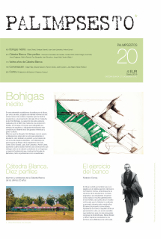Confessions
DOI:
https://doi.org/10.5821/palimpsesto.20.8895Keywords:
Architecture, Art, Ephemeral, Knowledge, Transversality.Abstract
At a time when, facing of a new reality, architecture is exposed more than ever to its elastic capacity, having the need to define new professional profiles that have blurred the classic figure of the architect beyond the pure building, I take the invitation of this magazine on the 20th anniversary of Cátedra Blanca to share a vision of the profession, as an opportunity to review the impact, value and influence of art and the mixture between architects, thinkers and artists, through ephemeral architecture.
The lack of art complexes to formulate uncomfortable questions and find new expressive languages, allowed many architects to see in their free nature the opportunity to discover all kinds of synergies by mixing with each other, thus building bridges between seemingly independent disciplines when betting on transversality. From this experience resulted in many cases the definition of new postulates that changed the way of understanding contemporary architecture. From Jackson Pollock to Mark Rothko, through the mutual influence between the members of the Independent Group or the CoBrA group, and the value of their work together in the form of ephemeral spaces (and their ability to establish those as manifestos), in which the challenge It is to give palpable form to knowledge.
Downloads
Published
Issue
Section
License
PROTECTION AND INTELLECTUAL PROPERTY CRITERIA
Authors whose work is published in en Palimpsesto agree to the following terms:
1. The author retains the copyrights and guarantees the magazine the right to apply a Creative Commons Attribution-NonCommercial-NoDerivatives (CC BY-NC-ND), which permits others to share the work with acknowledgement of authorship.
2. The author may establish additional agreements of his or her own accord for non-exclusive distribution of the article published in the magazine (for example, in an institutional repository, or published in a book).
3. Electronic distribution of the work by the author(s) is permitted and encouraged (for example, in institutional repositories or on the author’s own website), prior to, and during the submission process, as this can generate productive exchanges, as well as earlier and greater citation of the published works (see The Effect of Open Access) (in English).
4. The author or provider of the material submitted for publication authorizes Palimpsesto to publish, with no obligation whatsoever (financial or otherwise) to the content of said material, be it in paper or digital format, or in any other medium.
5. The author or provider guarantees that he or she is the owner of the Intellectual Property rights to the contents provided, which encompasses the text and images/photographs/photographic works incorporated in the article.
6. The author or provider, exempts Palimpsesto magazine of all and any responsibility relating to violation of copyrights, thereby committing himself or herself to undertaking all efforts to assist Palimpsesto magazine in defence of any accusation, extra-judiciary, and/or judicial measures. Likewise, the author or provider will assume payment to Palimpsesto of any sum or compensation that must be paid to third parties for failure to comply with these obligations, be it the result of judicial, arbitrary or administrative decisions.
7. The submission of the texts by authors implies automatically a declaration of non plagiarism of its contents







